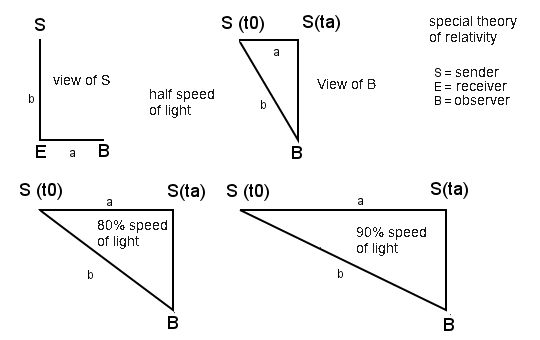Why is Nothing Faster than Light?
First explanation:
Based on the question answer,
a very fast object (like the cartoon character "Sonic") could change the entropy of the world. This is not possible, as explained above.
Thus, all speeds of material objects moving in space are limited
Second explanation (Special Relativity):
Second explanation (Special Relativity):
Two centaurs gallop side by side and shoot each other with arrows. An adjacent observer (B) is not hit only by the speed of the fired arrow.
There is also a component from the speed of the galloping centaur. This is different with light, because light has the same speed in every frame.

Two objects (spaceships, asteroids) fly side by side at a distance of one light-second (distance from Earth to the Moon).
Let them be called S (sender) and E (receiver). E hits observer B in one second (in time).
The observer is flying towards it at half the speed of light. At this moment, S sends light to E.
When E then touches B, B sees the light and S from the direction of the light.
Let the path length of the light be b, and a is the distance S travels in this time.
Because both times are equal, the lengths are related to the speed of S to the light.
Velocity in different systems is equal to each other in magnitude. As S approaches the speed of light,
its transmission time moves further and further into the past.
If S had the speed of light, its light would have been sent eternity ago. a and b are then equal.
However, only one second has passed at S. This scene corresponds to Einstein's light clock.
If you're interested:
a/b = v/c ; a≤ + 1 = b≤ (1 = one light second) according to Pythagoras; a≤ = b≤ ∑ v≤/c≤;
substituting this gives b = 1/sqrt(1-v≤/c≤) ; This gives the Lorentz factor.
Total symmetry:
Suppose B also sends a light beam perpendicularly into system S when S is still one second away.
At that point (in system B), the light beam from S to B is already on its way. Similarly, in system S,
the light beam from B to S has already been sent when S sends its signal perpendicularly into B's system.t.
Note:
Directions in different systems do not have to be the same. A car is traveling at 100 km/h.
The passenger throws a tin can backward at 30 km/h.
A pedestrian is hit on the back of the head by the tin can at 70 km/h, i.e., from the opposite direction.
Ludwig Resch